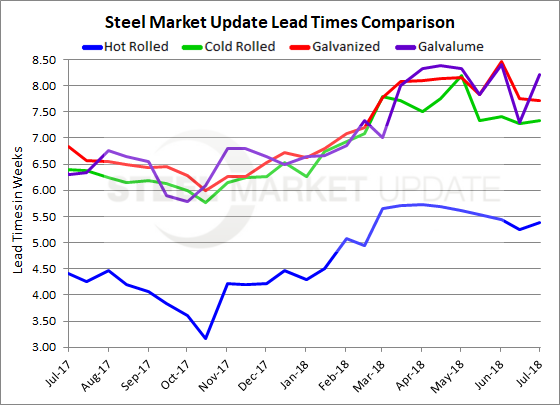SMU Data and Models

Steel Mill Lead Times: Not Much Change
Written by Tim Triplett
July 8, 2018
Mill lead times on most flat rolled steel products saw little change in the past two weeks, according to Steel Market Update’s latest market trends data. Lead times for hot rolled now average nearly five and a half weeks, cold rolled a bit less than seven and a half weeks, and galvanized a bit more than seven and a half weeks. Lead times for Galvalume made the biggest move from mid-June to more than eight weeks. These lead times are more extended now than what Steel Market Update measured at this time one year ago (see graphic below).
Lead times on hot rolled steel peaked in early April at 5.73 weeks and generally have trended downward since then. Hot rolled lead times now average 5.39 weeks based on the responses from this week’s market trends questionnaire, up slightly from 5.24 weeks in mid-June. They are still extended compared with a year ago, however, when HRC lead times averaged 4.41 weeks.
Cold rolled lead times are at 7.33 weeks, up slightly from 7.27 weeks in mid-June. Cold roll lead times have been as high as 8.19 weeks in early May. Last year at this time, CR lead times averaged 6.40 weeks.
The current lead time for galvanized steel is 7.71 weeks, down slightly from 7.76 weeks in mid-June and 8.46 weeks one month ago. A year ago, lead times on spot orders of galvanized averaged 6.84 weeks.
At 8.22 weeks, Galvalume lead times bumped up from 7.29 weeks in SMU’s last poll, returning to about where they were in the first week of June.
Lead times for steel delivery are a measure of demand at the mill level. The more extended the lead time, the busier the mills. Recent changes in lead times have been too small to discern a clear trend as the market approaches mid-summer.
Note: These lead times are based on the average from manufacturers and steel service centers who participated in this week’s SMU market trends analysis. Our lead times do not predict what any individual may get from any specific mill supplier. Look to your mill rep for actual lead times. Our lead times are meant only to identify trends and changes in the marketplace. To see an interactive history of our Steel Mill Lead Times data, visit our website here.

Tim Triplett
Read more from Tim TriplettLatest in SMU Data and Models

SMU’s June at a glance
A look at SMU data for the month of June.

SMU Survey: Buyers’ Sentiment rebounds from multi-year low
Both of SMU’s Steel Buyers’ Sentiment Indices edged higher this week. Current Sentiment rebounded from a near five-year low, while Future Sentiment rose to a two-month high

SMU flat-rolled market survey results now available
SMU’s latest steel buyers market survey results are now available on our website to all premium members.

SMU Survey: Sheet lead times pull back after early-June blip, plate holds
Following the uptick seen two weeks ago, lead times eased this week for all four sheet products tracked by SMU, while plate lead times held steady, according to this week’s market survey.

SMU Survey: Pricing power abruptly shifts to steel buyers
The majority of steel buyers responding to our latest market survey say domestic mills are more willing to talk price on sheet and plate products than they were earlier this month. Sheet negotiation rates rebounded across the board compared to early June, while our plate negotiation rate hit a full 100%.

